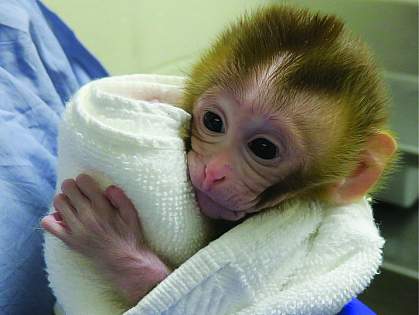You are here
April 2, 2019
Primate study shows progress with cryopreserved testicular tissue
At a Glance
- Tissue containing sperm-producing stem cells from prepubescent monkeys was successfully frozen and grafted into the monkeys months later.
- After puberty, the grafted tissue produced live sperm that resulted in the first primate baby born using such “cryopreserved” tissue.
- These results move fertility preservation for young boys closer to clinical studies.

Advances in treatment mean that more and more childhood cancer survivors are living to adulthood. But the chemotherapy and radiation therapy that helped save their lives can have long-term effects on health. One of these is infertility: about a third of childhood cancer survivors can’t have children of their own.
If a boy has gone through puberty before treatment, he can store his sperm. But prepubescent boys don’t yet produce sperm. Researchers have been investigating ways to preserve sperm-producing stem cells and use them later to restore fertility. These cells are present even in very young boys.
A team led by Dr. Kyle Orwig at the University of Pittsburgh has been working to improve preservation and grafting of the testicular tissue that contains these sperm-producing stem cells. In a proof-of-principle study of their technique, they froze and grafted testicular tissue collected from prepubescent rhesus monkeys.
After the monkeys matured, the researchers removed the grafts and used the resulting sperm to attempt in vitro fertilization and pregnancy. The research was funded in part by NIH’s Eunice Kennedy Shriver National Institute of Child Health and Human Development (NICHD). Results were published on March 22, 2019, in Science.
Testicular samples taken from five monkeys were frozen for up to five months. Each monkey then received grafts of their own preserved tissue, sewn under the skin in both the scrotum and the back. As the monkeys entered puberty, male hormone production increased, showing that the grafts were functional.
Between 8 and 12 months after grafting, the testicular tissue was removed from the graft sites. In all the grafts from both the scrotum and the back, the tissue pieces had grown together and increased about fivefold in size. The researchers saw mature sperm production in all the graft samples.
The team used sperm from one monkey for fertility testing. Sixteen embryos were created with in vitro fertilization techniques, and eleven were transferred to six female monkeys. A healthy baby was born in the spring of 2018. She is the first primate baby conceived using sperm-producing tissue that was collected and cryopreserved before adolescence. The baby monkey will be followed for years to make sure she develops normally.
Some questions remain to be answered before the procedure could be tested in people. The monkeys in the experiments had both their testicles removed before grafting. Further studies will be needed to test whether grafting will work in animals with intact testicles. This approach may not be appropriate for some people, such as leukemia and testicular cancer patients, who could have cancer cells hiding in their testicular tissue.
Despite the need for future research in these areas, Orwig says, “This advance is an important step toward offering young cancer patients around the world a chance at having a family in the future.”
Related Links
- Preserving Sperm Stem Cells Restores Fertility in Mice
- Infertility Treatments Don’t Appear to Affect Children’s Development
- How Sperm are Activated
- Fertility Issues for Adolescents and Young Adults with Cancer
- Infertility and Fertility
- What is Fertility Preservation?
References: Autologous grafting of cryopreserved prepubertal rhesus testis produces sperm and offspring. Fayomi AP, Peters K, Sukhwani M, Valli-Pulaski H, Shetty G, Meistrich ML, Houser L, Robertson N, Roberts V, Ramsey C, Hanna C, Hennebold JD, Dobrinski I, Orwig KE. Science. 2019 Mar 22;363(6433):1314-1319. doi: 10.1126/science.aav2914.PMID: 30898927.
Funding: NIH’s Eunice Kennedy Shriver National Institute of Child Health and Human Development (NICHD) and Office of the Director (OD); Magee-Womens Research Institute and Foundation.
